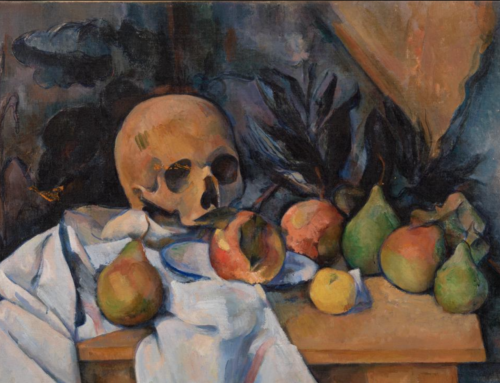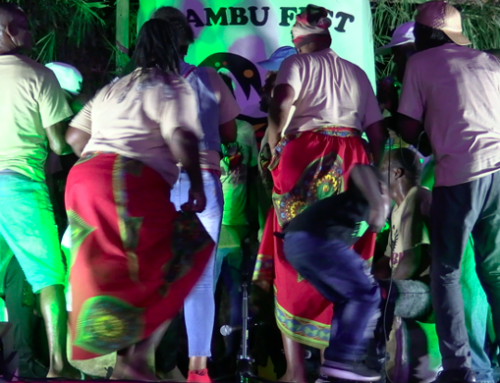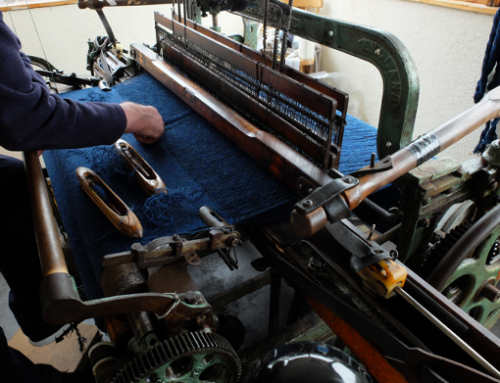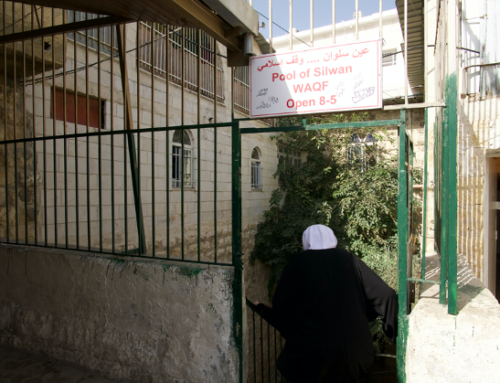On March 11, 2011, a mega-earthquake struck Japan. Unforeseen high tsunami waves engulfed entire towns along the Northeastern coastline, black liquid washing away houses, cars, and bodies in a heartbreaking instant. The strongest earthquake ever recorded in Japan’s history also destroyed buildings and infrastructures further south in Chiba prefecture, where my parents live and where I grew up. I was in Yangon, Myanmar, when it happened. After scrambling to confirm my parents’ and friends’ safety, I watched—frustrated and devastated—video after video of the destruction on my small laptop screen. A month later, I left my PhD fieldwork early to return to Japan. My parents had spent about a week without running water, but by the time I arrived, faucets were working and the only traces of the event appeared on the cracked surfaces of the sidewalks, which made me trip in unexpected places. Train stations dimmed their lights to save energy amidst the nuclear reactor failures in Fukushima. I spent the next few months volunteering at a Japanese humanitarian NGO, where I had worked before my PhD, to help secure relief items from the Tokyo office and carry out emergency activities in Ishinomaki in northern Japan, one of the worst affected cities.
Many people in Japan have had painful disaster experiences, either from earthquakes or from other hazards such as floods. Japan also has one of the most thorough disaster risk reduction (DRR) systems in the world in terms of regulations, infrastructure, and preparedness culture. Given all of this, when I began my new project on disaster preparedness in 2017, I was surprised to hear government officials, municipal employees, and community organizers involved in disaster preparedness education (bōsai kyōiku)—people I call “preparedness educators”—lament that the majority of people in Japan do not engage with preparedness in their daily lives. Whether this is due to “normalcy bias”—that is, the tendency to disbelieve that a disaster can happen to oneself—or lack of time and resources (Krüger et al. 2015; Lewis et al. 2011), the present seems to be what is most elusive for preparedness educators. How do you make future disasters, and therefore preparedness, “real” in people’s present lives?
In Japan, I have worked most closely with a nonprofit social design organization called Plus Arts. It is known for its use of games and fun activities to teach children and their families how to be prepared for disasters and reduce risks at home. One type of game teaches players how to turn everyday items into potential resources for survival. For example, a card game called Namazu no Gakkō (“School of Catfish”) presents different disaster scenarios based on interviews with survivors of the 1995 Hanshin-Awaji Earthquake in the city of Kobe.
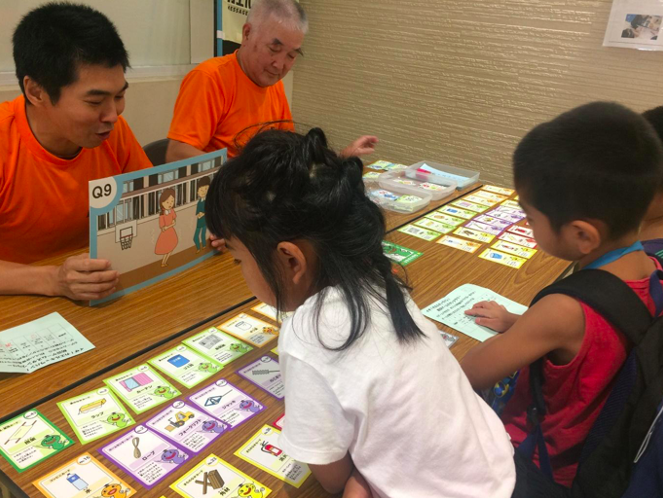
Community organizers facilitating a Namazu no Gakkō (“School of Catfish”) game with children in Kobe, Japan, from August 8, 2017. Photo by author.
Players need to propose items that might be useful in a given scenario, illustrated as a cute cartoon with clean lines and solid colors. Each player begins with a random set of cards showing items such as a magazine, a raincoat, or a plastic trash bag. The adult facilitator reads a script describing the situation. One setting shows someone with a broken arm and asks what players can use to secure the arm. The players put the best item from their hand of cards in the middle of the table. The items need to be readily accessible during a disaster and easy to use for anyone.
Once all the players have put down a card and discussed their choices, the facilitator reads out the answers using another set of pictures. There are usually about four or five possible answers to a question, each with a different number of points. The highest points go to the item that disaster survivors said was most useful—in the case of the broken arm, the best answer is a magazine, which survivors were able to roll up and use to stabilize broken limbs. Discussing the reasoning behind the other answers that players offered is an important part of the game.
In August 2019, I was explaining this game to my research collaborator, Dr Shūhei Kimura from the University of Tsukuba. He commented that Plus Arts’ games appeared to be about “seeing things in a doubled-up or duplicate way” (nijūka shite miru). It is about dislodging the framework of the everyday (nichijō no furēmu wo hazusu). His comment was astute, echoing theories of play that I had been grappling with. Earlier that year, at a seminar in London, an audience member had suggested that I read Ian Bogost’s work. In his book, Play Anything, Bogost (2016, 79) writes:
In Marshall McLuhan’s terms, fun is the process of flipping figure and ground, taking something unseen and forcing it to become visible again or anew and taking something obvious and hiding it away temporarily.
Bogost’s main point is that play, and relatedly fun, is not about “free play”; it is about doing what we can with the limited materials and situations at hand, and doing something different than their intended purpose or original context. Similarly, Gregory Bateson, watching animals in a zoo, explained that a nip in a different context might indicate a bite—that is, aggression—but in the context of playing, it points to the opposite meaning (Bateson 1969). The nip, therefore, acts only “as if” it were a bite, not “really” a bite (a fight) but an act of fun or even affection.
Playfulness, therefore, is a way to take A and treat it as B. The magazine, or the rubbish bag, or the cardboard box leftover from a delivery is an ordinary object in the present, but when looked at differently, it can become a resource for survival in a future disaster. This is how preparedness educators strive to reconstitute the future in the present, creating the possibility of worlds where a disaster will not destroy lives because people will know how to mitigate it and survive. Here, time is not sequential in a linear progression; past, present, and future co-exist like parallel universes. The “labor in and of time” (Bear 2014) of preparedness educators creates reversible figures out of time—the past, present, and future always already there in ordinary life. What you see as being in the present (a magazine that you finished reading) can appear to be the future (an arm brace in a disaster) when you look at it differently. And as the ordinary object transforms into other possible uses, the present begins to seem as if it harbors other potential futures, other potential scenarios of disaster and survival. Preparedness educators use playful methods to convince other people that constructing different futures in the present is as easy as learning to see an object in more ways than one.
Just as the present has been elusive for preparedness educators, it has been a central problematic for anthropologists (Fabian 1983; Hastrup 1990; Pina-Cabral 2000). While debates on the ethnographic present have generally centered on issues of writing and representation, time also has an impact on the practices of knowledge production. Liana Chua (2015) problematizes presence and the present in ethnographic research as pointing to its fundamentally relational character. Anthropologists, as much as our interlocutors, do not conduct research as isolated and ahistorically static subjects. Our ethnographic trajectories are shaped by contingent and situated fieldwork encounters, as well as “by our reading material, conference attendance, professional rivalries and collaborations, peer review, and the demands of our personal lives” (Chua 2015, 656). Just as playful preparedness educators show us the multiplicity of time and the co-existence of past, present, and future, Chua points to the multiplicity of ourselves.
Chua’s insight resonates with the notion of patchwork ethnography that I have been developing with other scholars (Günel et al. 2020). In my PhD project, I commuted to the NGO office that was my official “field site” from my parents’ apartment where I grew up, so small that I could hear them breathing as they slept (Cardoza et al. 2021). I wrote about the daily routines and fights with my parents in my field notes but they never appeared in my final thesis or publications. I want to change that in my next book. I want to be honest about the multifaceted relational entanglements and constraints, personal and professional, that constitute knowledge production.
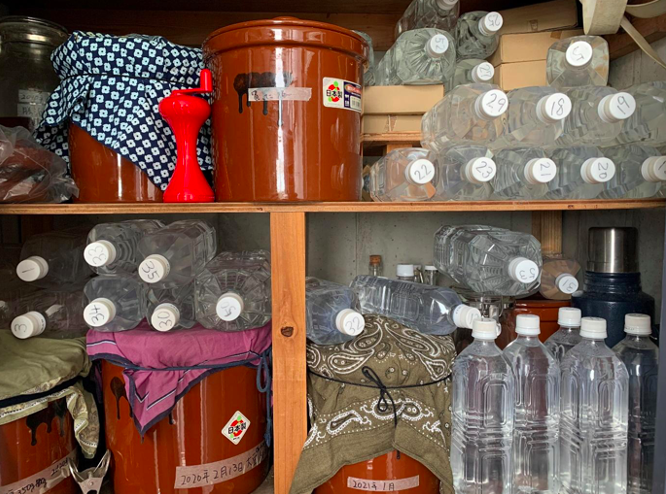
Bottles of stockpiled water on a shelf, with numbers to indicate their order of expiration, illustrating an example of disaster preparedness at home by the author’s mother, from January 19, 2023. Photo by author.
In this spirit, when I was in Japan in early 2023, I decided to ask my mother about her disaster experiences and preparedness practices at home. I always knew that she prepared for disasters quite thoroughly but had never directly asked her about it. Her response took me aback: she referred to March 11, 2011 as “when she had been affected by the disaster” (hisai shita toki). The Japanese word “hisai” is used to qualify people or places stricken by a disaster, such as “hisaisha” to indicate a “disaster victim.” My mother had told me before about seeing paved streets undulate like waves with the effects of liquification and that they did not have running water for about a week. My father went to the municipal trucks to get buckets of water and went to the public baths to wash, all while commuting for an hour every day to work. But they had electricity and could flush the toilet. I did not think of them as “hisai.”
In April 2011, I went looking for disaster-affected places in northern Japan. It never occurred to me that disaster-affected people, even if to a lesser degree than those in the north, were right there, at home. Listening to my mother, I realized that the present is multiple, and so am I, as simultaneously a researcher and a daughter. But I make choices about which one to prioritize—at which moment to be present and which self to be. I chose to ignore my parents’ existence in my search for a kind of virtuous co-presence—perhaps a humanitarian co-presence rather than an ethnographic one, but a sense of being righteously in “the field” nonetheless (Redfield 2006). There are always many possible presents available to us. We all make a choice because we cannot be everywhere at once. Recognizing that our present is not the only one could be a way to make room for other worlds and other futures possible in our anthropological research.
References
Bateson, Gregory. 1969. Steps to an Ecology of Mind. Chicago: University of Chicago Press.
Bear, Laura. 2014. “Doubt, Conflict, Mediation: The Anthropology of Modern Time.” Journal of the Royal Anthropological Institute 20 (S1): 3–30. https://doi.org/10.1111/1467-9655.12091.
Bogost, Ian. 2016. Play Anything: The Pleasure of Limits, the Uses of Boredom, and the Secret of Games. New York: Basic Books.
Cardoza, Danny, Chika Watanabe, Gökçe Günel, and Saiba Varma. 2021. “Interview: Patchwork Ethnography.” Society for Cultural Anthropology. June 10, 2021. https://culanth.org/fieldsights/interview-patchwork-ethnography.
Chua, Liana. 2015. “Troubled landscapes, troubling anthropology: co-presence, necessity, and the making of ethnographic knowledge.” Journal of the Royal Anthropological Institute 21 (3): 641–59. https://doi.org/10.1111/1467-9655.12254.
Fabian, Johannes. 1983. Time and the Other: How Anthropology Makes Its Object. New York: Columbia University Press.
Günel, Gökçe, Saiba Varma, and Chika Watanabe. 2020. “A Manifesto for Patchwork Ethnography.” Society for Cultural Anthropology. https://culanth.org/fieldsights/a-manifesto-for-patchwork-ethnography.
Hastrup, Kirsten. 1990. “The Ethnographic Present: A Reinvention.” Cultural Anthropology 5 (1): 45–61.
Krüger, Fred, Greg Bankoff, Terry Cannon, Benedikt Orlowski, and Lisa F. Schipper, eds. 2015. Cultures and Disasters: Understanding Cultural Framings in Disaster Risk Reduction. London; New York: Routledge.
Lewis, James, Ilan Kelman, and Sarah A.V. Lewis. 2011. “Is ‘fear Itself’ the Only Thing We Have to Fear? Explorations of Psychology in Perceptions of the Vulnerability of Others.” Australasian Journal of Disaster and Trauma Studies 3: 89–104.
Pina-Cabral, João De. 2000. “The Ethnographic Present Revisited.” Social Anthropology 8 (3): 341–48. https://doi.org/10.1017/S0964028200000252.
Redfield, Peter. 2006. “A Less Modest Witness: Collective Advocacy and Motivated Truth in a Medical Humanitarian Movement.” American Ethnologist 33 (1): 3–26. https://doi.org/10.1525/ae.2006.33.1.3.
Chika Watanabe is a Senior Lecturer in Social Anthropology at the University of Manchester. She is the author of Becoming One: Religion, Development, and Environmentalism in a Japanese NGO in Myanmar. Her current book project examines how disaster preparedness educators in Japan and Chile seek to remake the future through the use of fun and play.
Cite As: Watanabe, Chika. 2024. “The Present as Patchwork”, In “Back to the Present” edited by Timothy P.A. Cooper, Michael Edwards & Nikita Simpson, American Ethnologist website, January 26 2024, [https://americanethnologist.org/online-content/collections/back-to-the-present/the-present-as-patchwork/]
